Investigating the Impact Behavior of Carbon Fiber/Polymethacrylimide (PMI) Foam Sandwich Composites for Personal Protective Equipment
Abstract
1. Introduction
2. Materials and Methods
2.1. Theoretical Basis of Material Design
2.2. Material Composition
2.3. Quasi-Static Compression Test
2.4. Low-Speed Impact Test
2.5. High-Speed Impact Tests
3. Results
3.1. Quasi-Static Compression Performance
3.2. Low-Speed Impact Performance
3.3. High-Speed Impact Performance
4. Discussion
4.1. Peak Stress Value under Different Impact Velocities
4.2. Energy Absorption Capacity under Different Impact Velocities
5. Limitations and Future Outlook
6. Conclusions
- (1)
- Under quasi-static conditions, increasing the face sheet thickness and core density of the carbon fiber/PMI foam sandwich panels can improve the plateau stress and compressive modulus of the specimens, but shorten the plateau time.
- (2)
- Under low-speed impact conditions, when the total thickness of the sandwich specimen remained unchanged, the larger the thickness of the core layer, the lower the overall peak stress value of the specimen. When the face layer did not show any damage, the peak stress did not change significantly with the foam density; however, when the specimen showed face sheet damage, the peak stress increased with the foam density.
- (3)
- Under high-speed impact conditions, within a single waveform period, increasing the core layer density also increased the peak stress of the specimen, but appropriately reduced the stress level during the plateau period. The thicknesses of the face and back panels did not have a sufficient influence on the stress–strain curve of the specimen.
- (4)
- Under an impact load, the carbon fiber/PMI foam sandwich panel can absorb energy through the cracking of the panel and deformation of the glue nail and foam. The deformation mode of the internal glue nail is manifested as micro-buckling and breaking. Specimens with thicker face layers and less damage exhibited faster responses and more severe breaking of the internal glue nails to the load. The impact integrity of the ceramic/UHMWPE composite panel was significantly lower than that of the form sandwich panel.
- (5)
- From the perspective of human body protection performance, when the specimen thickness was the same, the energy absorption value of the foam sandwich material increased with an increase in the impact speed, core layer density, and panel thickness. B-1 and A-1 exhibited slightly higher energy absorption capacities than the ceramic/UHMWPE composite panel under low-speed impact.
Author Contributions
Funding
Institutional Review Board Statement
Informed Consent Statement
Data Availability Statement
Conflicts of Interest
References
- Ulmer, N.; Barten, D.G.; De Cauwer, H.; Gaakeer, M.I.; Klokman, V.W.; van der Lugt, M.; Mortelmans, L.J.; van Osch, F.H.; Tan, E.C.; Boin, A. Terrorist attacks against hospitals: World-wide trends and attack types. Prehospital Disaster Med. 2022, 37, 25–32. [Google Scholar] [CrossRef] [PubMed]
- Ibrahim Shire, M.; Hersi, A. Brothers in arms: The phenomenon of complex suicide attacks. Terror. Political Violence 2022, 34, 263–284. [Google Scholar] [CrossRef]
- De Cauwer, H.; Barten, D.G.; Tin, D.; Mortelmans, L.J.; Ciottone, G.R.; Somville, F. Terrorist attacks against concerts and festivals: A review of 146 incidents in the Global Terrorism Database. Prehospital Disaster Med. 2022, 38, 33–40. [Google Scholar] [CrossRef] [PubMed]
- Dale Bass, C.; Davis, M.; Rafaels, K.; Steve Rountree, M.; Harris, R.M.; Sanderson, E.; Andrefsky, W.; DiMarco, G.; Zielinski, M. A methodology for assessing blast protection in explosive ordnance disposal bomb suits. Int. J. Occup. Saf. Ergon. 2005, 11, 347–361. [Google Scholar] [CrossRef] [PubMed]
- Weng, P.Y.; Kang, L.F.; Kong, C.F.; Li, Y.Q.; Zhu, C.Y. Preparation and high velocity impact performance of combined 3-D woven composites. J. Text. Res. 2016, 37, 60–65. [Google Scholar]
- Potter, A.W.; Hunt, A.P.; Pryor, J.L.; Pryor, R.R.; Stewart, I.B.; Gonzalez, J.A.; Xu, X.; Waldock, K.A.; Hancock, J.W.; Looney, D.P. Practical method for determining safe work while wearing explosive ordnance disposal suits. Saf. Sci. 2021, 141, 105328. [Google Scholar] [CrossRef]
- Guo, Y.X.; Yuan, M.Q.; Qian, J.M.; Zhao, L. Study on mechanical behavior and response characteristics of inner concave honeycomb structure under impact load. J. Saf. Sci. Technol. 2019, 15, 5–10. [Google Scholar]
- Bach, A.J.; Costello, J.T.; Borg, D.N.; Stewart, I.B. The Pandolf load carriage equation is a poor predictor of metabolic rate while wearing explosive ordnance disposal protective clothing. Ergonomics 2016, 60, 430–438. [Google Scholar] [CrossRef] [PubMed]
- Stewart, I.B.; Rojek, A.M.; Hunt, A.P. Heat strain during explosive ordnance disposal. Mil. Med. 2011, 176, 959–963. [Google Scholar] [CrossRef]
- Wu, Y.N.; Norton, A.; Zielinski, M.R.; Kao, P.C.; Stanwicks, A.; Pang, P. Characterizing the Effects of Explosive Ordnance Disposal Operations on the Human Body While Wearing Heavy Personal Protective Equipment. Human Factors 2022, 64, 1137–1153. [Google Scholar] [CrossRef]
- Chen, J.; Lv, W.J.; Zhu, L.M. Functional study and design of miners’ protective clothing. Light Text Ind. Technol. 2013, 42, 15–17. [Google Scholar]
- Zhou, Y.G. The past and present of blast injury research in China. Chin. J. Traumatol. 2015, 18, 7. [Google Scholar] [CrossRef] [PubMed]
- Phillips, Y.Y.; Mundie, T.G.; Yelverton, J.T.; Richmond, D.R. Cloth ballistic vest alters response to blast. J. Trauma Acute Care Surg. 1988, 28, S149–S152. [Google Scholar] [CrossRef] [PubMed]
- Cooper, G.J.; Townend, D.J.; Cater, S.R.; Pearce, B.P. The role of stress waves in thoracic visceral injury from blast loading: Modification of stress transmission by foams and high-density materials. J. Biomech. 1991, 24, 273–285. [Google Scholar] [CrossRef] [PubMed]
- Young, A.J.; Phillips, Y.Y.; Jaeger, J.J.; Fletcher, E.R.; Richmond, D.R. Intrathoracic pressure in humans exposed to short duration airblast. Mil. Med. 1985, 150, 483–486. [Google Scholar] [CrossRef]
- Skews, B.W.; Takayama, K. Flow through a perforated surface due to shock-wave impact. J. Fluid Mech. 1996, 314, 27–52. [Google Scholar] [CrossRef]
- Wanchoo, P.; Matos, H.; Rousseau, C.E.; Shukla, A. Investigations on air and underwater blast mitigation in polymeric composite structures—A review. Compos. Struct. 2021, 263, 113530. [Google Scholar] [CrossRef]
- Seibert, H.F. PMI foam cores find further applications. Reinf. Plast. 2000, 44, 36–38. [Google Scholar]
- Norman, F.S. Collapse mechanisms of sandwich beams with composite faces and a foam core, loaded in three-point bending. Part II: Experimental investigation and numerical modeling. Int. J. Mech. Sci. 2004, 46, 585–608. [Google Scholar]
- Yu, B.; Han, B.; Ni, C.Y.; Liu, J.F.; Zhang, Q.C.; Lu, T.J.; Ci, J.; Geng, L. Numerical study on impact performance of hollow and PMI foam filled aluminum corrugated plate. Chin. J. Appl. Mech. 2015, 49, 6. [Google Scholar]
- Deng, Y.F.; Zhu, J.Q. Study on the High-Speed Impact Response of the PMI Foam Sandwich Structure. In Proceedings of the 2018 National Academic Conference on Solid Mechanics Summary Set F, Harbin, China, 23 November 2018. [Google Scholar]
- Lai, J.M.; Ruan, J.Q.; Wang, S.; Huang, Z. Study on the flexural behavior of stitched foam-core sandwich panels. Mater. Rep. 2020, 34, 18165–18170. [Google Scholar]
- Du, Y.; Keller, T.; Song, C.; Wu, L.; Xiong, J. Origami-inspired carbon fiber-reinforced composite sandwich materials—Fabrication and mechanical behavior. Compos. Sci. Technol. 2021, 205, 108667. [Google Scholar] [CrossRef]
- Mahgoub, M.; Zhang, Y.; Yang, C.; Tan, Z. Dynamic responses of sandwich beams with polymethacrylimide (PMI) foam cores when subjected to impact loading. Materials 2023, 16, 1108. [Google Scholar] [CrossRef] [PubMed]
- Zhu, Y.F.; Sun, Y.G. Low-velocity impact response of multilayer foam core sandwich panels with composite face sheets. Int. J. Mech. Sci. 2021, 209, 106704. [Google Scholar] [CrossRef]
- Chen, J.; Cheng, L.; Sun, H.; Yao, X.; Fu, C.; Jiang, J. The influence of pin on the low-velocity impact performance of foam sandwich structure. Int. J. Mech. Sci. 2023, 244, 108057. [Google Scholar] [CrossRef]
- Fan, Z.H. Study on the Dynamic Response and Failure of Foam-Reinforced Composite Lattice Sandwich Structure under Impact Load. Ph.D. Thesis, Huazhong University of Science and Technology, Wuhan, China, 2020. [Google Scholar]
- Franz, T.; Nurick, G.N.; Perry, M.J. Experimental investigation into the response of chopped-strand mat glassfibre laminates to blast loading. Int. J. Impact Eng. 2002, 27, 639–667. [Google Scholar] [CrossRef]
- Zheng, C.; Zhang, D.; Liang, Y.; Qian, K. Anti-explosive performance of fabric/polyurea (FPU) soft composites: A review. Mater. Rep. 2021, 35, 23205–23211. [Google Scholar]
- Jing, L.; Wang, Z.H.; Zhao, L.M. Advances in studies of the mechanical performance of cellular metals and related sandwich structures. Mech. Eng. 2015, 37, 1–24. [Google Scholar]
- Sousa, M.J.; Teixeira, D.F. Using natural cellular materials to improve blast-wave protection. Int. J. Mater. Eng. Innov. 2011, 2, 165–178. [Google Scholar]
- Hayman, B. Underwater explosion response of sandwich structures with compliant cores. In Blast Mitigation Strategies in Marine Composite and Sandwich Structures; Gopalakrishnan, S., Rajapakse, Y., Eds.; Springer: Singapore, 2018; pp. 23–52. [Google Scholar]
- Wan, S.L.; Yin, C.; Jiao, S.J. Transient response of plastic foam cladding to deep water explosion. Noise Vib. Control 2015, 35, 115–119. [Google Scholar]
- Tao, X.X.; Sun, X.W.; Shi, W.; Wang, X.H.; Luo, X.L. Influence of design parameters on anti-explosion performance of honeycomb sandwich structure with negative Poisson’s ratio. J. Ordnance Equip. Eng. 2021, 42, 74–79. [Google Scholar]
- ISO 844:2021; Rigid cellular plastics—Determination of Compression Properties. International Organization for Standardization (ISO): Geneva, Switzerland, 2021.
- ISO 6603-2:2023; Plastics—Determination of Puncture Impact Behaviour of Rigid Plastics—Part 2: Instrumented Impact Testing. International Organization for Standardization (ISO): Geneva, Switzerland, 2023.
- Shyr, T.W.; Pan, Y.H. Impact resistance and damage characteristics of composite laminates. Compos. Struct. 2003, 62, 193–203. [Google Scholar] [CrossRef]
- Ouellet, S.; Cronin, D.; Worswick, M. Compressive response of polymeric foams under quasi-static, medium, and high strain rate conditions. Polym. Test. 2006, 25, 731–743. [Google Scholar] [CrossRef]
- Gibson, L.J.; Ashby, M.F. Cellular Solids—Structures and Properties, 2nd ed.; Cork: Cambridge, UK, 1997. [Google Scholar]
- Ren, C.X.; Hu, Z.F.; Yao, C.; Mo, F. Experimental study on the quasi-static compression behavior of multilayer aluminum foam sandwich structure. J. Alloys Compd. 2019, 810, 151860. [Google Scholar] [CrossRef]
- Tarlochan, F. Sandwich structures for energy absorption applications: A review. Materials 2021, 14, 4731. [Google Scholar] [CrossRef] [PubMed]
- Zhou, H.; Liu, R.; Hu, Y.; Song, P.; Guo, R. Quasi-static compressive strength of polymethacrylimide foam-filled square carbon fiber reinforced composite honeycombs. J. Sandw. Struct. Mater. 2021, 23, 2358–2374. [Google Scholar] [CrossRef]
- Flores-Johnson, E.; Li, Q.M.; Shen, L. Numerical simulations of quasi-static indentation and low velocity impact of Rohacell 51 WF foam. Int. J. Comput. Meth. 2014, 11 (Suppl. S1), 1344004. [Google Scholar] [CrossRef]
- Feng, D.; Aymerich, F. Effect of core density on the low-velocity impact response of foam-based sandwich composites. Compos. Struct. 2020, 239, 112040. [Google Scholar] [CrossRef]
- Luo, C.; Cao, H.J.; Huang, X.M. Numerical simulation on low velocity impact response of three-dimensional sandwich composites with different core height. J. Text. Res. 2019, 40, 7. [Google Scholar]
- Wang, H.; Li, T.T.; Wu, L.; Lou, C.W.; Lin, J.H. Spacer fabric/flexible polyurethane foam composite sandwiches: Structural design and quasi-static compressive, bursting and dynamic impact performances. J. Sandw. Struct. Mater. 2021, 23, 1366–1382. [Google Scholar] [CrossRef]
- Schimizze, B.; Son, S.F.; Goel, R.; Vechart, A.P.; Young, L. An experimental and numerical study of blast induced shock wave mitigation in sandwich structures. Appl. Acoust. 2013, 74, 1–9. [Google Scholar] [CrossRef]
- Tarlochan, F.; Ramesh, S.; Harpreet, S. Advanced composite sandwich structure design for energy absorption applications: Blast protection and crashworthiness. Compos. Part B Eng. 2012, 43, 2198–2208. [Google Scholar] [CrossRef]
- Jia, S.; Wang, C.; Xu, W.; Ma, D.; Qi, F. Experimental investigation on weak shock wave mitigation characteristics of flexible polyurethane foam and polyurea. Def. Technol. 2024, 31, 179–191. [Google Scholar] [CrossRef]
- Grisaro, H.Y.; Benamou, D.; Dancygier, A.N. Effects of fragments impact on reinforced concrete protective elements. Procedia Eng. 2017, 210, 306–311. [Google Scholar] [CrossRef]
- Chu, B. Investigaiton on Dynamic Mechanical Behavior of Solid Foam and Stress Wave Propagation in It. Ph.D. Thesis, Tongji University, Shanghai, China, 2013. [Google Scholar]
- Eyvazian, A.; Moeinifard, M.; Musharavati, F.; Taghizadeh, S.A.; Mahdi, E.; Hamouda, A.M.; Tran, T.N. Mechanical behavior of resin pin-reinforced composite sandwich panels under quasi-static indentation and three-point bending loading conditions. J. Sandw. Struct. Mater. 2021, 23, 2127–2145. [Google Scholar] [CrossRef]
- Guruprasad, S.; Mukherjee, A. Layered sacrificial claddings under blast loading Part I—Analytical studies. Int. J. Impact Eng. 2000, 24, 957–973. [Google Scholar] [CrossRef]
- Milić, P.; Marinković, D.; Klinge, S.; Ćojbašić, Ž. Reissner-Mindlin Based Isogeometric Finite Element Formulation for Piezoelectric Active Laminated Shells. Tech. Gaz. 2023, 30, 416–425. [Google Scholar]
- Milić, P.; Marinković, D.; Ćojbašić, Ž. Geometrically Nonlinear Analysis of Piezoelectric Active Laminated Shells by Means of Isogeometric FE Formulation. Facta Univ. Ser. Mech. 2023. [Google Scholar]
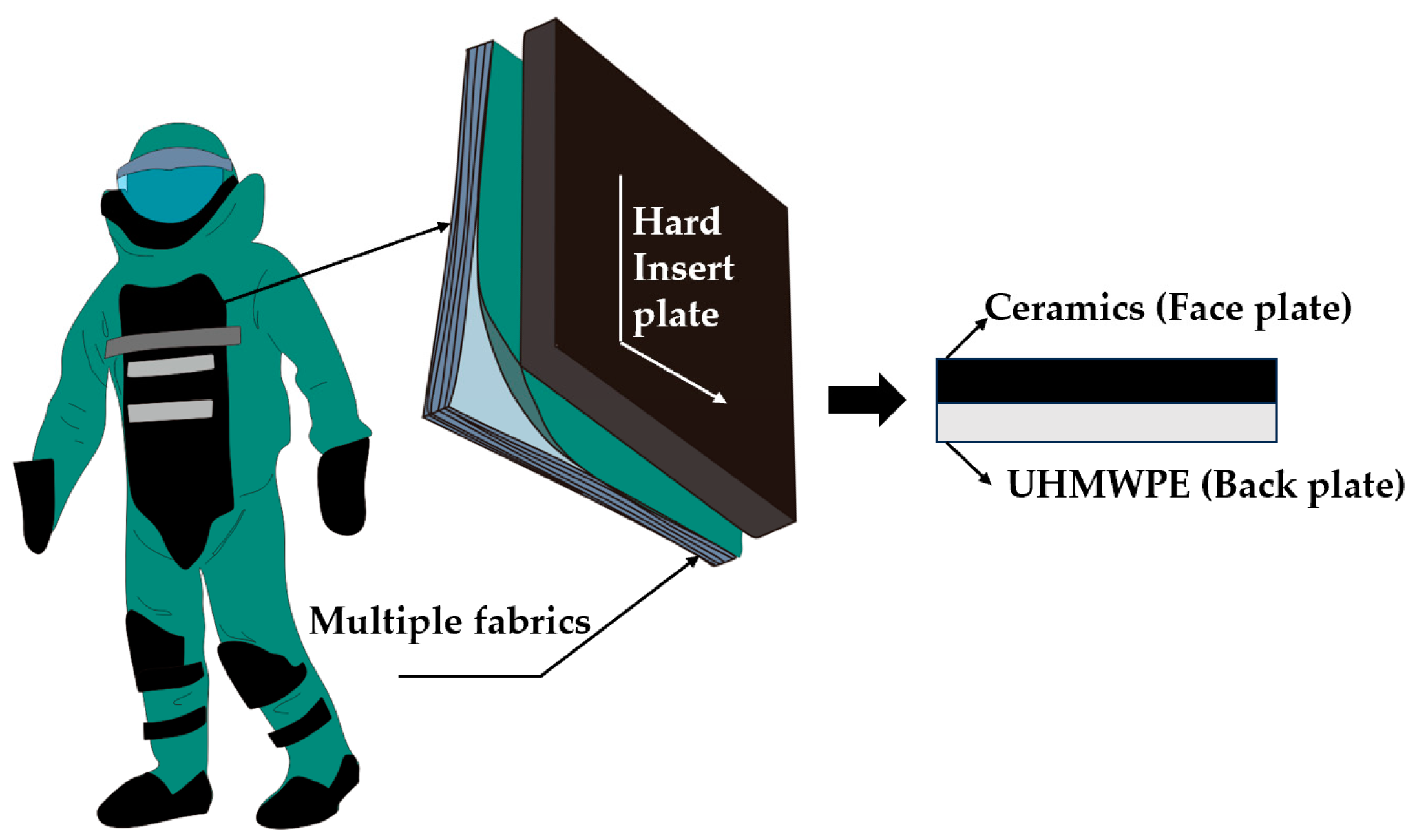
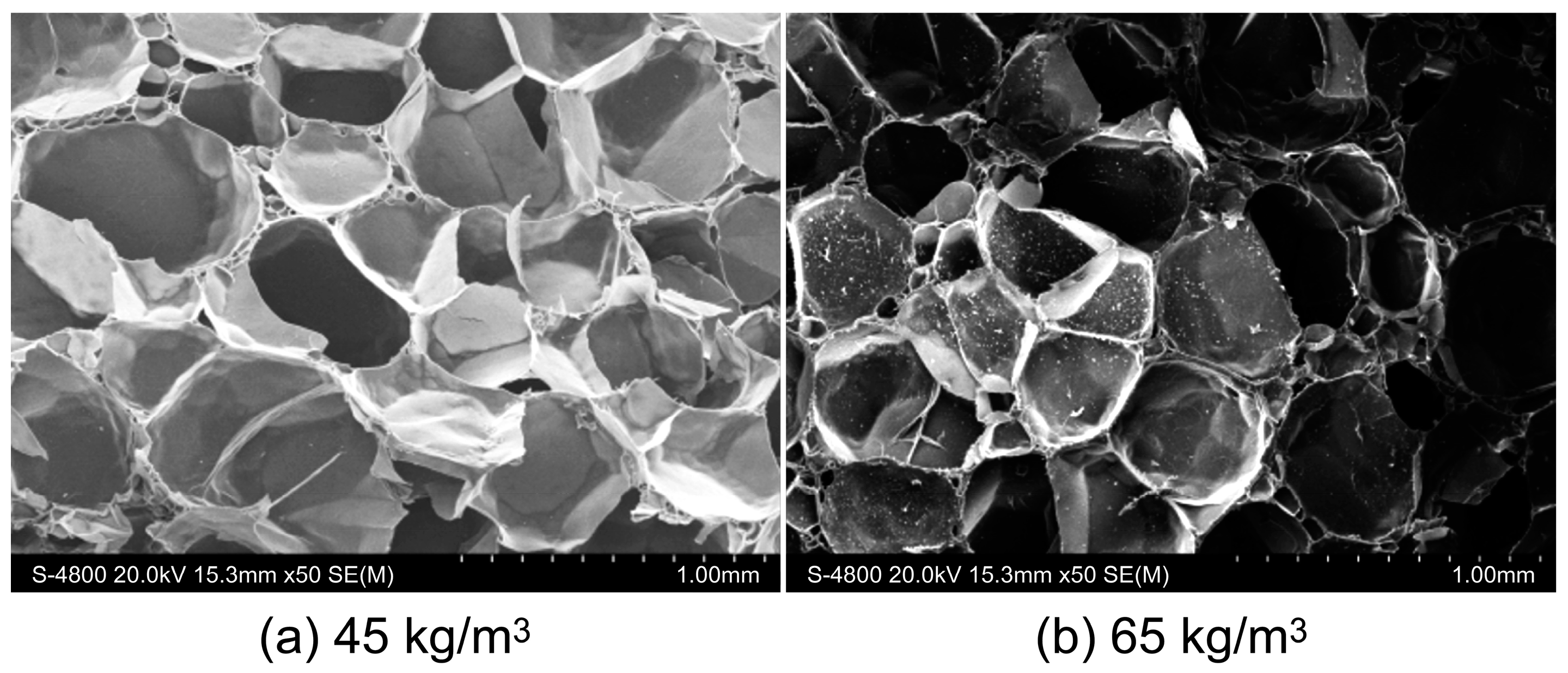


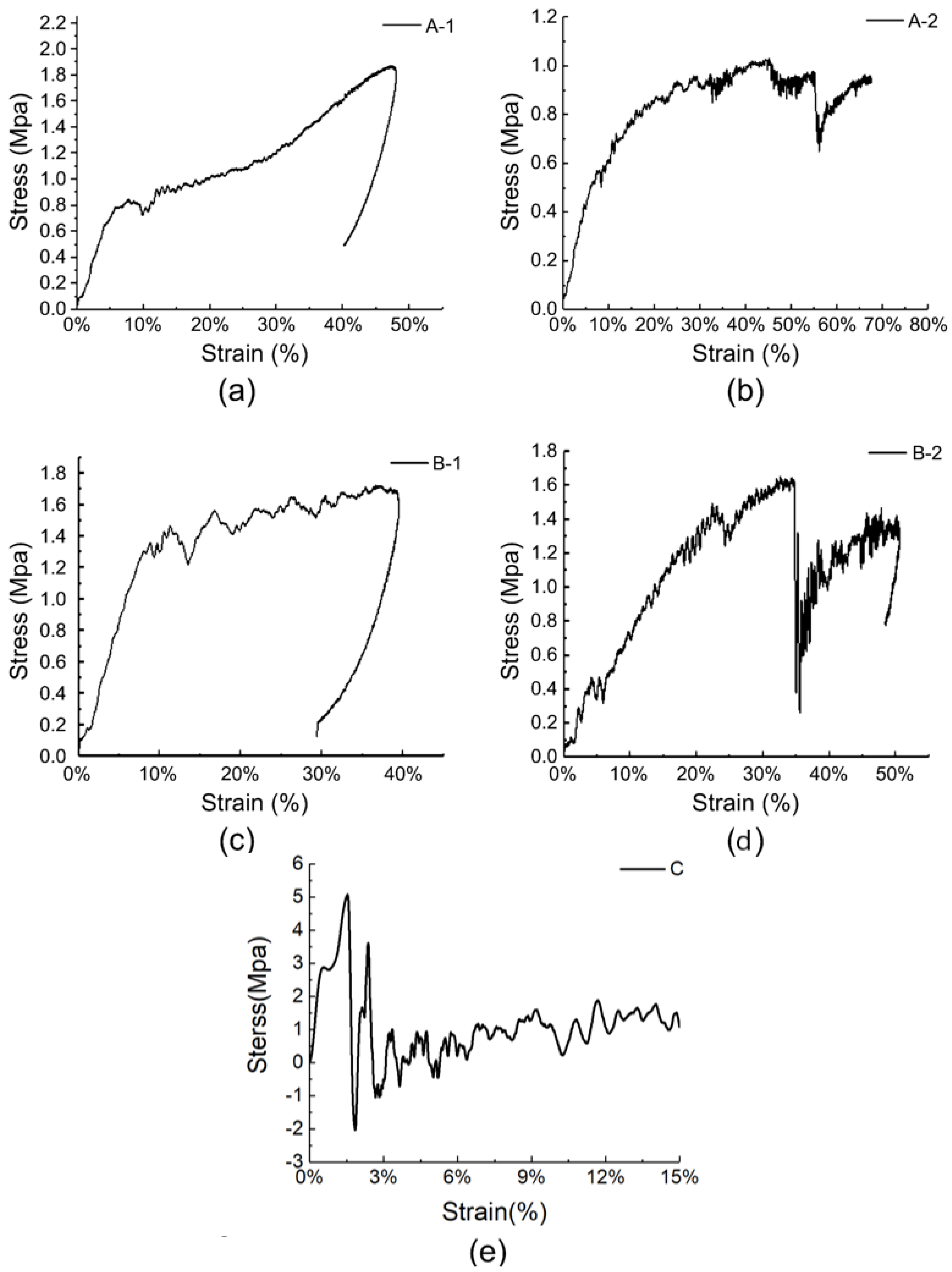
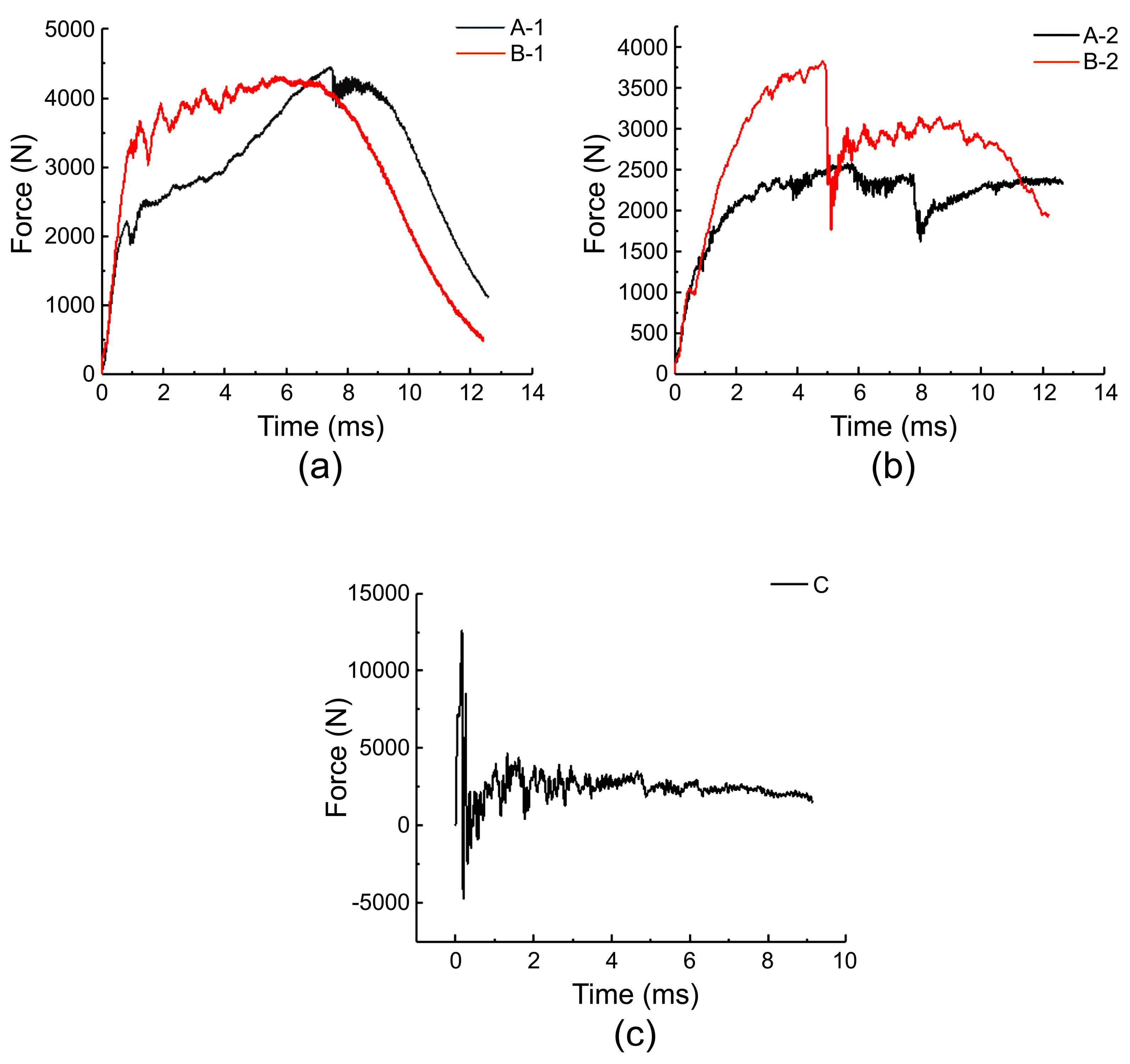
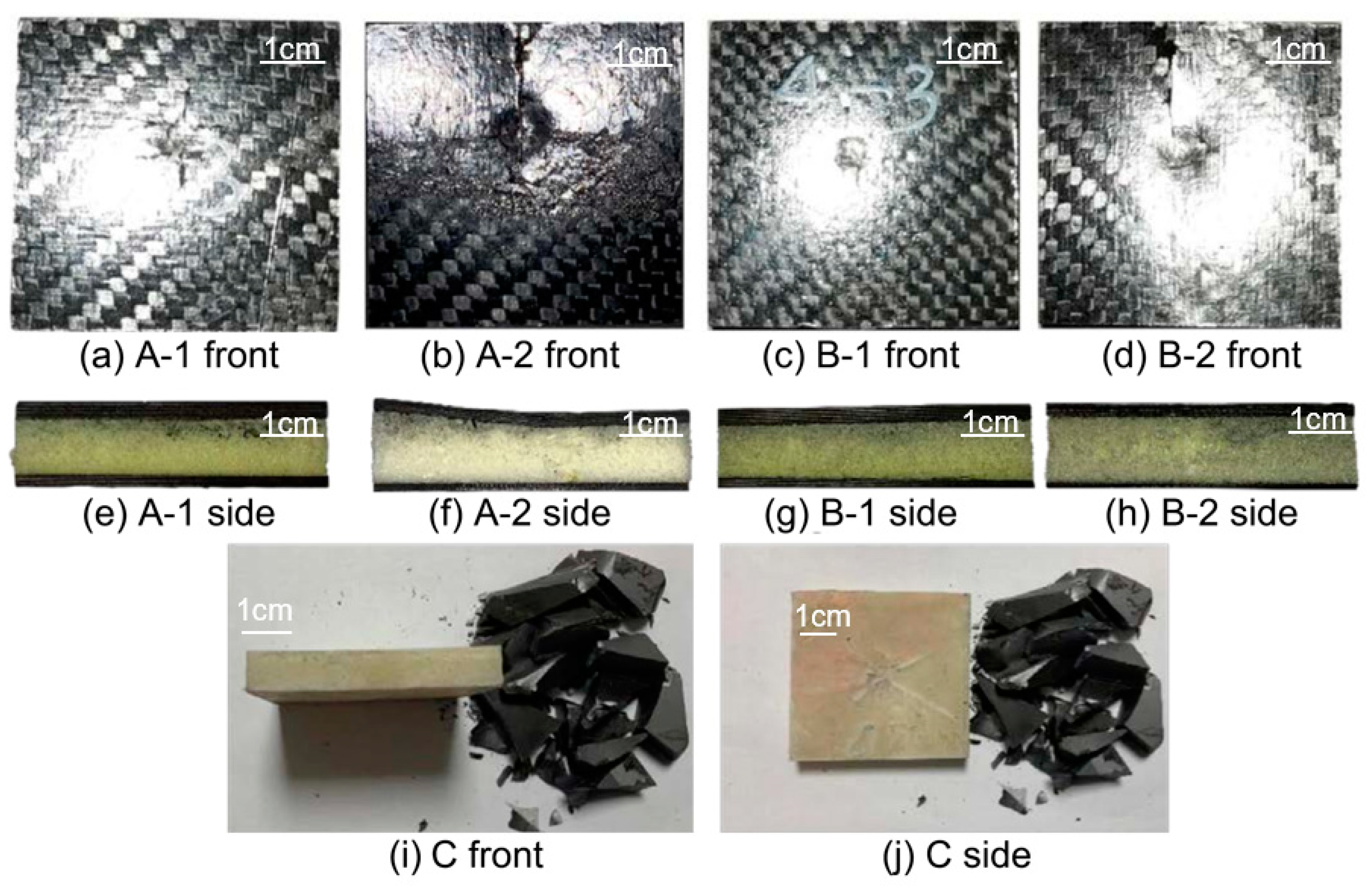




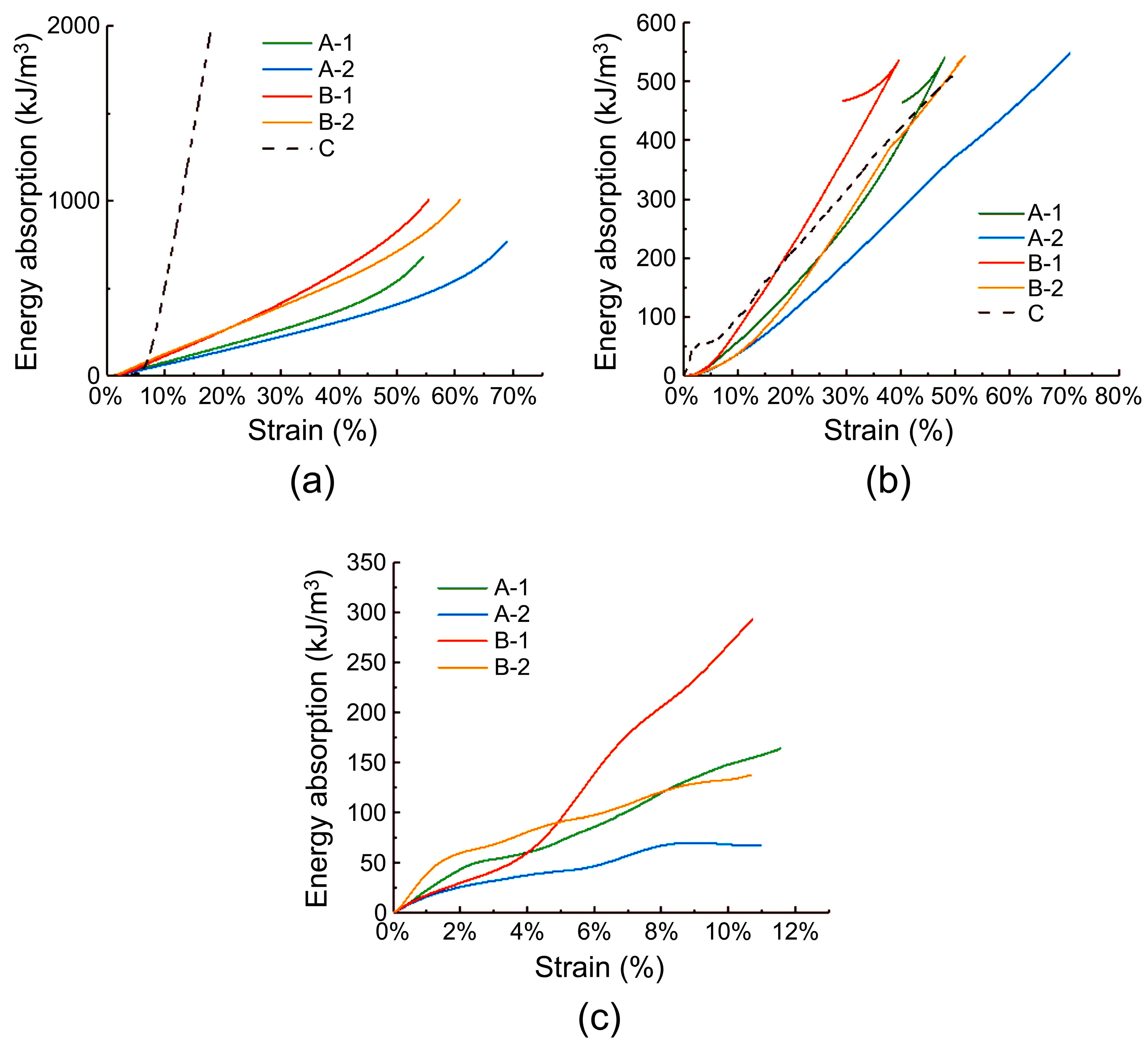
| Alternatives | Composition | Thickness (mm−1) | Density (kg·m−3) | |||
|---|---|---|---|---|---|---|
| Face Layer | Core | Back Layer | Core | Specimen | ||
| A-1 | Carbon fiber/PMI foam/Carbon fiber | 3 | 11 | 2 | 45 | 454.47 |
| A-2 | Carbon fiber/PMI foam/Carbon fiber | 2 | 13 | 1 | 45 | 321.54 |
| B-1 | Carbon fiber/PMI foam/Carbon fiber | 3 | 11 | 2 | 60 | 492.23 |
| B-2 | Carbon fiber/PMI foam/Carbon fiber | 2 | 13 | 1 | 60 | 330.08 |
| C | Ceramic/UHMWPE | 8 | / | 8 | / | 2053.43 |
| Alternatives | Compressive Strength/MPa | Compressive Modulus/MPa | ||
|---|---|---|---|---|
| Mean | CV (%) | Mean | CV (%) | |
| A-1 | 0.92 | 1.8 | 65.70 | 1.3 |
| A-2 | 0.87 | 0.6 | 35.41 | 6.8 |
| B-1 | 1.53 | 1.8 | 76.35 | 2.8 |
| B-2 | 1.35 | 2.1 | 58.35 | 9.6 |
| C | / | / | 278.51 | 4.7 |
| Alternatives | Material Composition | Density (kg·m−3) | Number of Layers | Energy Absorption Value at 10% Strain (kJ/m3) | |||||
|---|---|---|---|---|---|---|---|---|---|
| Quasi-Static Compression | Low-Speed Impact | High-Speed Impact | |||||||
| Mean | CV (%) | Mean | CV (%) | Mean | CV (%) | ||||
| A-1 | Carbon fiber/PMI | 454.47 | 3 | 76.96 | 0.8 | 61.52 | 8.2 | 147.25 | 8.7 |
| A-2 | Carbon fiber/PMI | 321.54 | 3 | 62.81 | 1.0 | 37.29 | 2.4 | 68.10 | 12.3 |
| B-1 | Carbon fiber/PMI | 492.23 | 3 | 117.05 | 1.1 | 84.92 | 3.9 | 266.11 | 6.9 |
| B-2 | Carbon fiber/PMI | 330.08 | 3 | 122.80 | 0.7 | 38.44 | 9.8 | 132.55 | 6.2 |
| C | Ceramic/UHMWPE | 2053.43 | 2 | 503.11 | 1.2 | 101.68 | 17.8 | / | / |
Disclaimer/Publisher’s Note: The statements, opinions and data contained in all publications are solely those of the individual author(s) and contributor(s) and not of MDPI and/or the editor(s). MDPI and/or the editor(s) disclaim responsibility for any injury to people or property resulting from any ideas, methods, instructions or products referred to in the content. |
© 2024 by the authors. Licensee MDPI, Basel, Switzerland. This article is an open access article distributed under the terms and conditions of the Creative Commons Attribution (CC BY) license (https://creativecommons.org/licenses/by/4.0/).
Share and Cite
Zhang, X.; Tian, M.; Li, J.; Chen, X. Investigating the Impact Behavior of Carbon Fiber/Polymethacrylimide (PMI) Foam Sandwich Composites for Personal Protective Equipment. Materials 2024, 17, 1683. https://doi.org/10.3390/ma17071683
Zhang X, Tian M, Li J, Chen X. Investigating the Impact Behavior of Carbon Fiber/Polymethacrylimide (PMI) Foam Sandwich Composites for Personal Protective Equipment. Materials. 2024; 17(7):1683. https://doi.org/10.3390/ma17071683
Chicago/Turabian StyleZhang, Xinyu, Miao Tian, Jun Li, and Xinggang Chen. 2024. "Investigating the Impact Behavior of Carbon Fiber/Polymethacrylimide (PMI) Foam Sandwich Composites for Personal Protective Equipment" Materials 17, no. 7: 1683. https://doi.org/10.3390/ma17071683
APA StyleZhang, X., Tian, M., Li, J., & Chen, X. (2024). Investigating the Impact Behavior of Carbon Fiber/Polymethacrylimide (PMI) Foam Sandwich Composites for Personal Protective Equipment. Materials, 17(7), 1683. https://doi.org/10.3390/ma17071683








